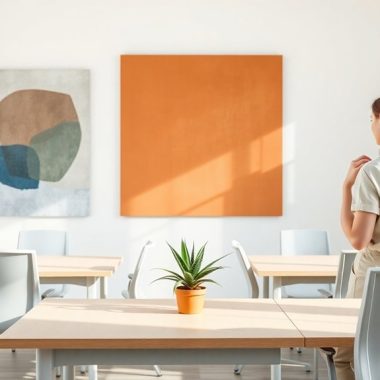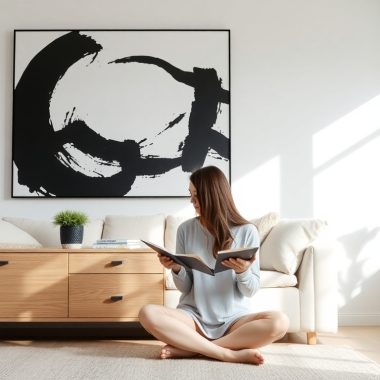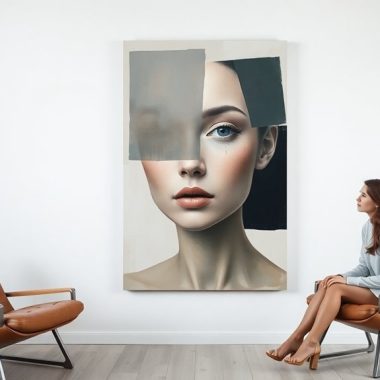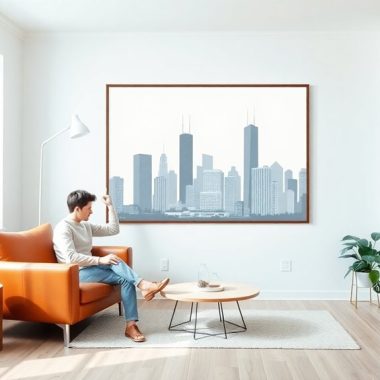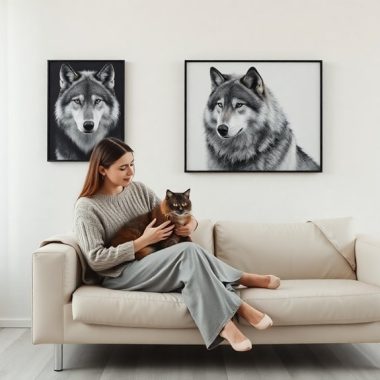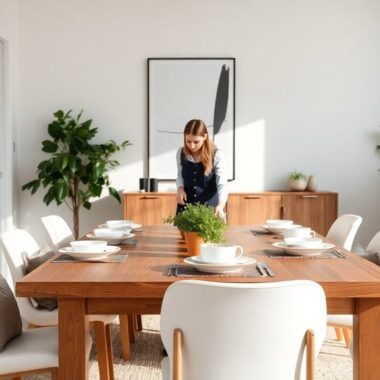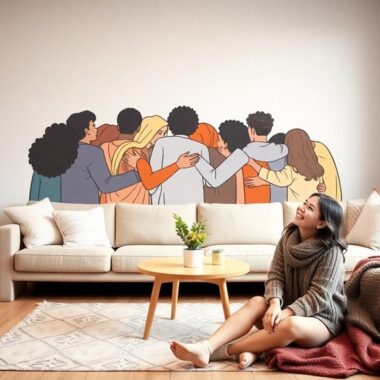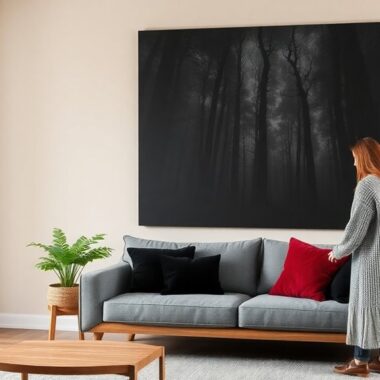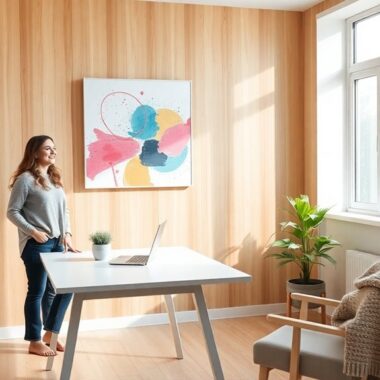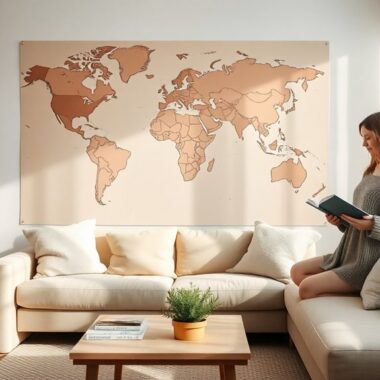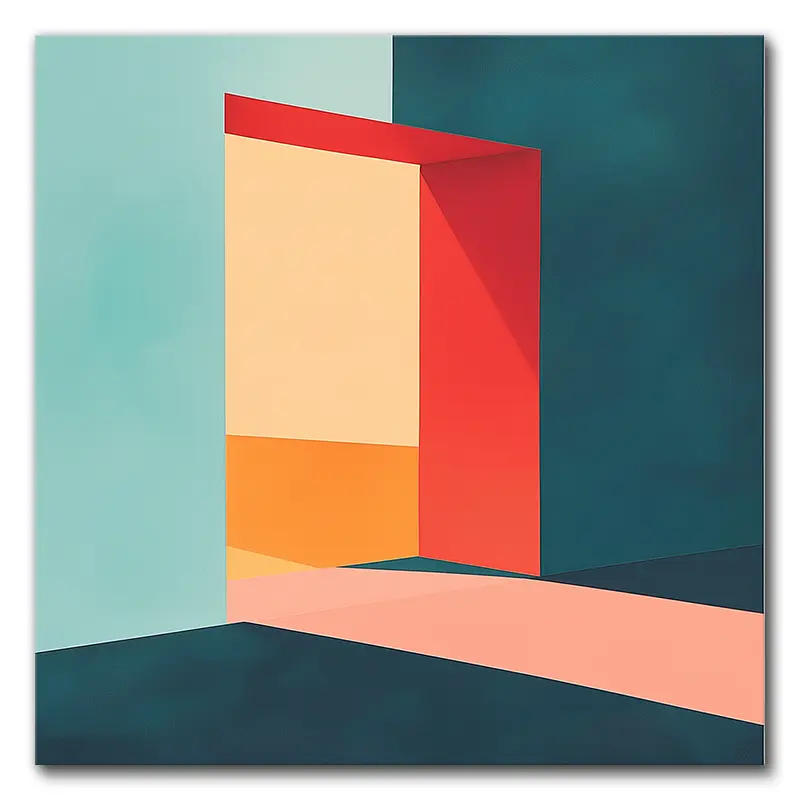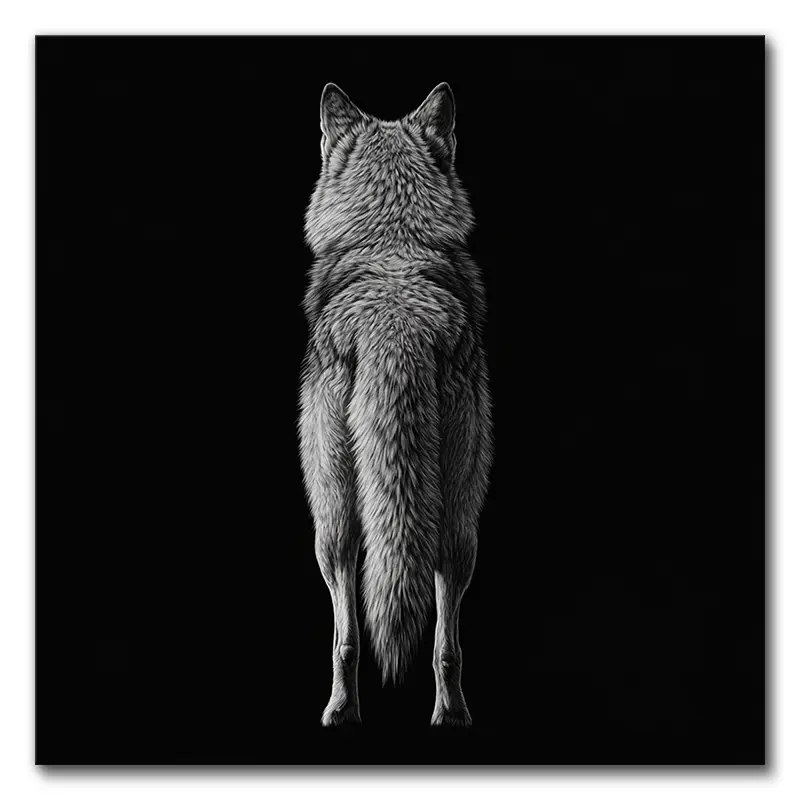Ditch the generic posters and transform your walls from meh to magnificent. Start by knowing your space—measure twice, buy once. Your art should scream YOUR personality, not some mass-produced garbage from a big-box store. Color psychology is your secret weapon: warm tones create energy, cool colors calm things down. Size matters, so don't slap a tiny canvas on a massive wall like a sad postage stamp. Mix textures, play with unexpected combinations, and break those boring design rules. Layer canvases, create asymmetrical clusters, and tell your story through art. Stick around, and we'll show you how to turn those blank walls into a masterpiece that'll make your friends jealous.
Know Your Space
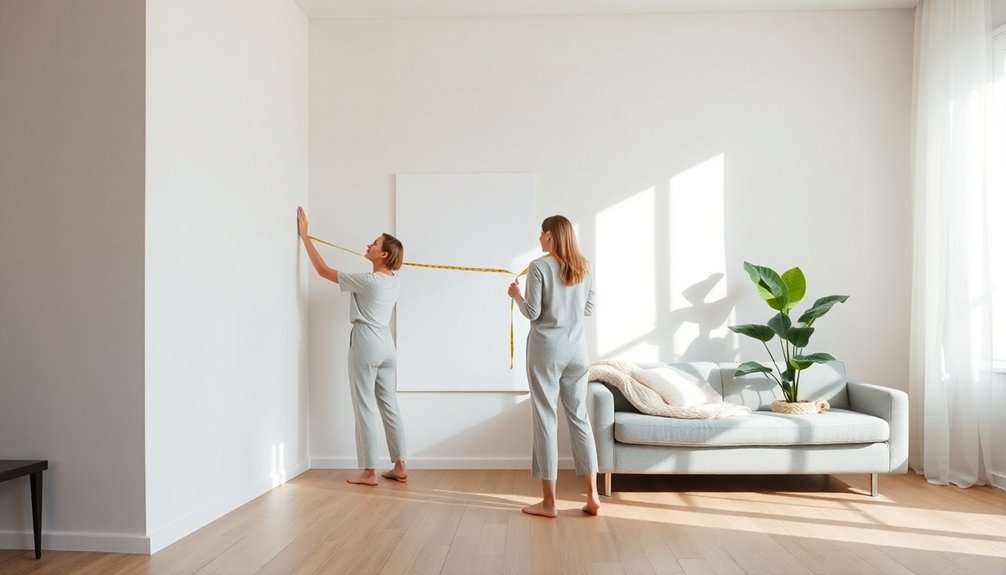
Before selecting canvas wall art, you'll need to carefully assess your available space. This isn't just about measuring dimensions—it's about understanding the room's vibe, personality, and functional purpose. Your wall art isn't just decoration; it's a strategic artistic statement that can dramatically transform a space from bland to brilliant.
Start by examining your room's existing color palette, furniture style, and architectural features. Is your living room modern and minimalist, or does it scream vintage eclectic? Your canvas art should complement, not clash. High-ceilinged rooms can handle larger, more dramatic pieces, while smaller spaces require more strategic, compact selections.
Consider traffic flow and viewing angles. You don't want a massive canvas blocking doorways or becoming an awkward obstacle people have to navigate around. Think about eye level and how people will experience the artwork when they enter the room. A piece hung too high or too low can look bizarrely disconnected.
Lighting matters immensely. Natural light, overhead fixtures, and ambient lamps will interact differently with your canvas. Some artworks will pop under direct light, while others might look washed out or create annoying glare. Additionally, incorporating transformative art features can enhance the visual appeal and mood of your space.
Pro tip: test potential placements by holding up your artwork and squinting—this helps you visualize the final effect without commitment.
Define Your Personal Style
Your canvas wall art should be a reflection of your unique personality and aesthetic preferences. Don't just hang random crap on your walls because some design magazine told you to. Your artistic influences matter, and your space should scream "THIS IS ME" without sounding like a desperate cry for attention.
Think about what genuinely moves you. Are you drawn to bold, graphic designs that punch you in the face with color? Or do you prefer subtle, moody landscapes that whisper introspective tales? Your personal expression isn't about following trends—it's about creating an emotional connection with the art that surrounds you.
Design inspirations can come from anywhere: that crazy trip you took to Barcelona, your grandmother's vintage photograph collection, or even your weird obsession with mid-century modern furniture. The key is authenticity. If a piece doesn't make you feel something—whether it's joy, nostalgia, or pure "holy sh*t, that's awesome"—then it doesn't belong on your wall.
Pro tip: Forget what others think. Your space is YOUR sanctuary. Mix styles, break rules, and create a visual narrative that's uniquely yours. Consider incorporating elements from nature, as pieces in the Green Wall Art collection can add a vibrant touch and foster a sense of calm.
Vintage botanical prints next to abstract expressionist pieces? Why the hell not. Minimalist black and white photography alongside vibrant pop art? Go for it.
Color Theory Matters
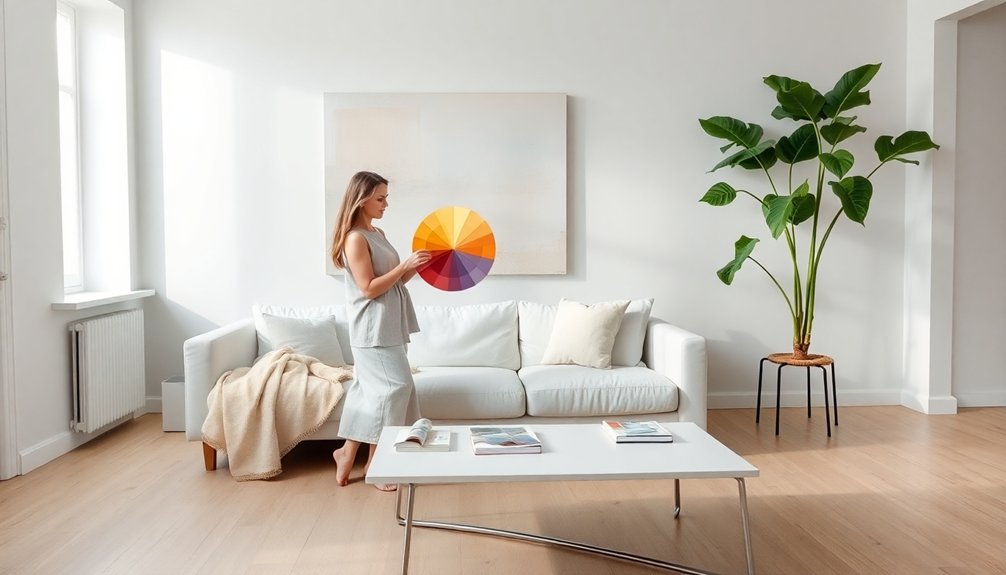
Let's face it: color isn't just about making things look pretty—it's a powerful psychological tool that can dramatically transform your living space.
Color psychology isn't some hipster design mumbo-jumbo; it's a legit way to control the emotional impact of your room.
When choosing canvas wall art, you'll want to understand color harmony like a pro. Those contrasting shades aren't just random—they're strategic weapons in your design arsenal.
Warm colors like reds and oranges can make a space feel energetic and intimate, while cool blues and greens create a sense of calm and expansiveness.
Don't ignore the cultural significance of colors, either. What might feel soothing to you could feel totally different to someone else.
Those seasonal palettes you've seen? They're not just trendy—they're carefully curated emotional landscapes.
Color saturation matters big time. A vibrant, high-intensity piece will scream for attention, creating an instant focal point.
Muted tones, on the other hand, whisper sophistication and understated elegance. Your canvas art isn't just decoration; it's a mood-setting powerhouse.
Pro tip: Consider the existing color scheme in your room. You're not just hanging art—you're creating a visual conversation.
Want to make a bold statement? Choose a piece that deliberately clashes.
Want harmony? Pick colors that complement your current decor. Additionally, incorporating green and white wall art can enhance the tranquility and renewal in your space.
Size and Scale Game
Once you've mastered color psychology, it's time to tackle another critical design element: canvas wall art size and scale. Let's get real about making your walls look killer, not like a freshman dorm room disaster.
Size isn't just a number—it's a game-changing strategy. Those canvas proportions aren't random; they're your secret weapon for creating visual magic. Want to make a statement? Go for an oversized impact that screams "I know exactly what I'm doing." A massive canvas in a minimalistic approach can transform a bland wall into a stunning focal point emphasis.
But here's the catch: scaling considerations aren't about throwing the biggest piece you can find onto your wall. It's about visual balance and harmony principles. Think of your wall like real estate—every inch counts. Smaller rooms need strategic placement, while larger spaces can handle more dramatic layering techniques.
Pro tip: measure your wall before buying. Nothing's more embarrassing than a canvas that looks like it was bought from a yard sale gone wrong. You want art that fits, not something that makes viewers do an awkward neck crane.
Consider the furniture around your canvas. It should complement, not compete. A piece above a sofa? Make sure it's about two-thirds the width of the furniture. Too small looks sad, too large looks like you're compensating.
Additionally, think about the decorative impact of your art; pieces like vibrant visuals can enhance the overall ambiance of your dining space.
Bottom line: size matters, but smart sizing matters more. Play the canvas game right, and your walls will thank you.
Theme and Mood Connection
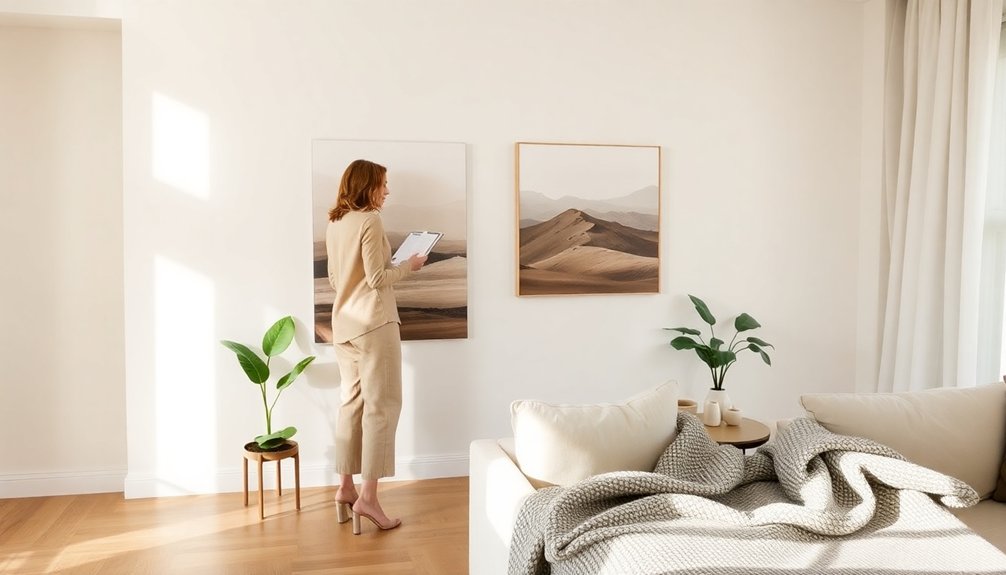
Emotion transforms canvas wall art from mere decoration into a powerful storytelling medium. When you choose wall art, you're not just hanging a picture—you're curating an emotional landscape that speaks volumes about your inner world. Your canvas becomes a visual narrative, broadcasting your personal style, cultural experiences, and deepest feelings.
Think of each piece as an opportunity for artistic expression that goes way beyond filling blank space. Want to create a zen-like living room? Choose serene landscapes or minimalist abstracts that whisper tranquility. Craving energy and passion? Bold, vibrant pieces with dynamic colors can inject serious attitude into your space.
Seasonal themes can also dramatically shift your room's emotional temperature. Summer-inspired art with bright, warm tones can combat winter blues, while moody, introspective pieces can perfectly capture autumn's contemplative spirit. Your wall art isn't just decoration—it's emotional engineering.
Thematic coherence matters big time. Don't just randomly grab something that "looks okay." Each piece should contribute to your room's emotional resonance. Cultural significance can add depth: a photograph from your travels, an artwork representing your heritage, or a piece that symbolizes a personal milestone.
Pro tip: Your canvas wall art should make you feel something. If it doesn't provoke an emotional response—whether that's excitement, calm, nostalgia, or pure badass energy—keep searching. Your walls aren't just walls; they're canvases for your personal narrative. Additionally, consider incorporating pieces from the Sand Wall Art collection, which are designed to promote relaxation and create inviting atmospheres in homes.
Mix Textures and Techniques
Raise your canvas wall art from flat to phenomenal by strategically mixing textures and artistic techniques. Boring, uniform walls are a design crime, and you've got the power to break those monotonous rules with smart texture contrast and technique variety.
Think of your wall art like a visual symphony. Some pieces should be smooth and sleek, while others demand rough, impasto brushstrokes that practically leap off the canvas. Imagine a minimalist geometric print sitting next to a wildly textured landscape painting – that's the kind of visual punch that'll make visitors stop and stare.
Experiment with mixed media canvases that blend photography, painting, and even 3D elements. Acrylic pours can sit beautifully alongside watercolor abstracts, creating depth and intrigue. Don't be afraid to play with unexpected combinations: metallic ink next to matte acrylics, or digital prints layered with hand-painted details.
Texture isn't just about how something looks – it's about how it makes you feel. A canvas with visible brush layers tells a story of movement and emotion. Rough, chunky paint suggests passion, while smooth, blended surfaces might whisper tranquility. For instance, light gray wall art can evoke feelings of tranquility amidst busy environments, enhancing the overall atmosphere of your space.
Pro tip: When mixing textures and techniques, maintain a cohesive color palette. This prevents your wall from looking like a chaotic art school explosion. Balance is key.
Your goal? Create a curated collection that's visually dynamic, personally meaningful, and absolutely impossible to ignore.
Quality Over Cheap Impulse
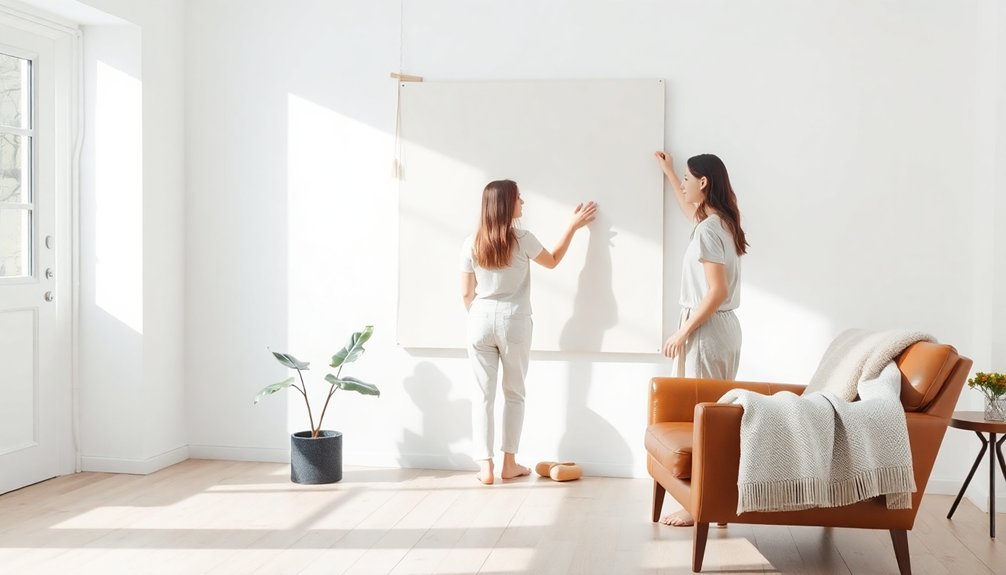
Five critical considerations should guide your canvas wall art purchase: durability, artistic integrity, material quality, long-term aesthetic value, and personal connection.
Listen up, art lovers: cheap impulse buys are the devil's playground for terrible home decor. Those $20 mass-produced canvas prints from big-box stores? They're basically visual trash that'll look faded and sad within months. When you're investing in art material, you're not just buying a decoration—you're purchasing a statement piece that'll live on your wall for years.
Budget considerations don't mean settling for crap. Smart shoppers understand that spending a bit more upfront means getting artwork that'll look stunning and maintain its quality. High-quality canvas prints use premium inks, professional-grade stretching techniques, and archival materials that resist fading and degradation. Additionally, consider the emotional impact of your chosen piece; the right artwork can evoke feelings of creativity and tranquility.
Think about it: would you rather have a disposable piece of wall decor that looks like a sad garage sale find, or an investment that makes your space feel curated and intentional? Quality canvas wall art tells a story. It reflects your taste, your personality, and your commitment to creating a space that doesn't scream "I bought this on a random Tuesday while impulse shopping."
Pro tip: research artists, check print quality, examine material durability, and don't be afraid to spend a little extra. Your walls deserve better than cheap, mass-produced garbage. Invest wisely, and your home will thank you.
Gallery Wall Magic
Gallery wall inspiration isn't about random placement—it's strategic art curation that turns blank spaces into jaw-dropping masterpieces. Want to nail those gallery wall trends? Start by understanding your space's personality. Mixed media works brilliantly: combine canvas prints, photographs, vintage sketches, and even quirky three-dimensional objects.
Don't be afraid to break traditional rules. Symmetry's cool, but controlled chaos can be even more enchanting. Pro tip: Before hammering holes everywhere, lay out your potential arrangement on the floor. Use kraft paper to trace and tape potential layouts on your wall—this prevents unnecessary Swiss-cheese walls and saves you from future patch-up headaches.
Consider your color palette, but don't get paralyzed by matching everything perfectly. Slight intentional imperfections create visual intrigue. Size matters, but not how you'd think. Mix large statement pieces with smaller complementary frames. Create visual weight by balancing bold and subtle elements.
Think of your gallery wall like a rock band—you need lead guitarists and backup singers working together. Pro move? Leave some breathing room between pieces. Overcrowding looks like a thrift store threw up on your wall. Aim for cohesion, not chaos.
Your gallery wall should tell a story—your story—without screaming it. To enhance your visual narrative, consider incorporating floral and botanical wall art as a way to bring nature's beauty indoors and create a serene atmosphere.
Placement and Lighting Tricks
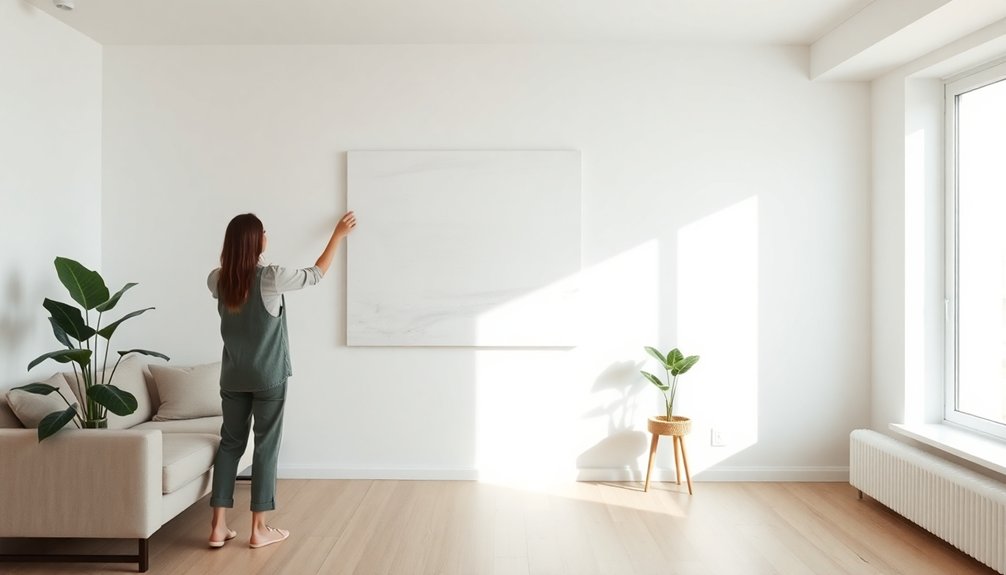
Behind every stunning canvas display, strategic placement and lighting can transform ordinary art into a mesmerizing visual experience. Your art arrangement isn't just about hanging something on the wall—it's about creating a visual narrative that captures attention and sparks conversation.
When positioning your canvas, consider these critical factors:
- Wall height matters—eye level is your sweet spot, typically 57-60 inches from the floor.
- Natural light can dramatically enhance or wash out your artwork's colors and details.
- Ambient illumination can create dramatic focal points and mood-setting effects.
Your canvas placement should feel intentional, not like an afterthought thrown up during a weekend cleaning spree.
Consider the room's architecture and existing furniture. A massive canvas above a tiny side table? Nope. That's visual chaos waiting to happen.
Lighting is where the real magic happens. Harsh overhead lights can flatten your artwork's depth, while strategic track lighting or directed spotlights can make your canvas pop like a rockstar.
Experiment with angles and intensity—subtle shifts can transform a flat image into a three-dimensional experience that draws viewers into its world. Additionally, incorporating Royal Blue Wall Art can bring a sense of tranquility and sophistication to your space.
Pro tip: Avoid direct sunlight, which can fade and damage your canvas over time.
Instead, use soft, indirect lighting that highlights your artwork's nuances without risking its long-term integrity. Your canvas is an investment, not a disposable decoration—treat it with the respect it deserves.
Break Traditional Design Rules
Design rebels, listen up: traditional canvas wall art rules are meant to be challenged, not blindly followed. Forget what those snooty interior design magazines tell you about perfect symmetry and predictable arrangements. Your walls are a canvas for personal expression, not a museum of boring conformity.
Breaking symmetry isn't just acceptable—it's downright exciting. Mix unconventional shapes that don't play nice together. Throw a circular canvas next to a jagged-edged rectangular piece and watch the magic happen. Bold contrasts are your new best friend: combine minimalist black and white photography with vibrant cultural-inspired artwork that screams personality.
Unexpected pairings can transform a mundane wall into a conversation starter. Who says you can't mix a vintage travel poster with a modern abstract piece? Playful arrangements challenge conventional wisdom and showcase your unique style. Layer canvases at different heights, overlap frames, or create asymmetrical clusters that defy traditional grid-like displays.
Cultural influences and symbolic meanings add depth to your wall art narrative. Don't just hang art—tell a story. Choose pieces that represent your journey, your passions, or your rebellious spirit. The White and Black Wall Art collection, for instance, highlights the importance of visual art in creating dramatic aesthetics that enhance your space.
Minimalist approaches can be powerful too: sometimes a single, striking piece speaks volumes more than a cluttered wall.
Your space, your rules. Break free from design dogma and create a wall that's authentically, unapologetically you. Design isn't about following rules—it's about making bold statements that reflect your inner creative badass.
Final Thoughts
Look, choosing canvas art isn't rocket science, but it's not a throw-dart-and-hope game either. Take Sarah's living room transformation: she went from bland beige walls to a jaw-dropping statement space by understanding her style and picking art that told her story. At VerVeLush, we live and breathe this art philosophy – helping you turn blank walls into personalized masterpieces that truly reflect who you are. Trust your gut, break some rules, and remember – with our curated collection and expert guidance, your walls are a canvas waiting to scream your unique personality. Make it count, and let VerVeLush be your design partner in creating spaces that are unmistakably you.


